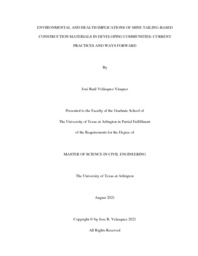| dc.description.abstract | For many years, artisanal and small-scale mining (ASM) communities around the world have been developing strategies to reduce contaminated mine tailings produced by mineral processing operations. These mine tailings are the by-product of the physical and chemical processes required to extract metals that humans require every day. The strategies developed by these communities cover a wide range of solutions, such as better practices in mineral processing activities as well as alternative technologies that help reduce the environmental impact of mining. Specifically, the recycling of mine tailings to produce construction materials has been of interest to researchers and communities.
The use of mine tailings for construction purposes has been documented in more than ten countries around the world, including Colombia, Peru, Bolivia, China, the United States, the Philippines, and Morocco. Although community efforts exist to recycle mine tailings into construction materials, most of these efforts have fallen short in addressing the environmental and health concerns that are created from the potential exposure to heavy metal contamination. This thesis aims to analyze the environmental and health aspects of mine tailings used for construction purposes by considering the studies developed by researchers, communities, and other organizations on this topic. In addition, limited social considerations are addressed in an effort to identify some key aspects from a community perspective. Possible impacts of using mine tailings as construction materials to the environment and human health are also discussed from a community engagement perspective.
Results show that mine tailings recycling activities (MTRAs) are generally focused on fabrication methods with an emphasis on the use of geopolymers and Ordinary Portland Cement (OPC) to produce construction materials. These construction materials consist mostly in bricks, pavers, and mortars, with a little emphasis in applications and final use. Environmental impact assessments are done by testing for heavy metal contamination using toxicity leaching tests such as the Toxicity Characteristic Leaching Procedure (TCLP) and other methods to determine the concentration of heavy metals in mine tailings and products. Health and social considerations are often overlooked in the process, lacking stakeholder perspectives and a comprehensive approach.
To understand the recycling of mine tailings into construction materials from a more holistic perspective, a Comprehensive Approach to Recycling Tailings (CART) framework is proposed. This framework is adapted from the Environmental Protection Agency (EPA) risk assessment procedure, and it proposes environmental and public health analyses that open possible avenues for future research in the recycling of mine tailings. Additionally, this framework illustrates social factors, which include the perception of risk that communities may have regarding the utilization of mine tailing-based-construction materials, as well as the gap that exists between the technical knowledge developed by researchers and the possible implementation in communities (i.e., research translation), stakeholder awareness, and community’s buy-in.
The dissemination work carried out in this thesis focuses mostly on developing activities that help communities understand these recycling initiatives and consider additional aspects such as the environment, people’s health, and community perception. This educational outreach includes the understanding of proper methods to deem these construction materials safe, as well as social considerations needed to properly implement mine tailing recycling in communities around the world.
Finding from this research will contribute to better assess mine tailing recycling activities from an ecological and public health perspective, by highlighting current methods developed worldwide and giving a different approach to the recycling of mine tailings. Researchers, academics, and people seeking to pursue these recycling activities may find a toolkit to develop a more comprehensive approach that allows them to give technical and scientific credibility to these mine-tailing recycled products. It will also contribute to the advancement of the communication between the scientific community and society to better tailor future initiatives to the community's needs and desires. | |


